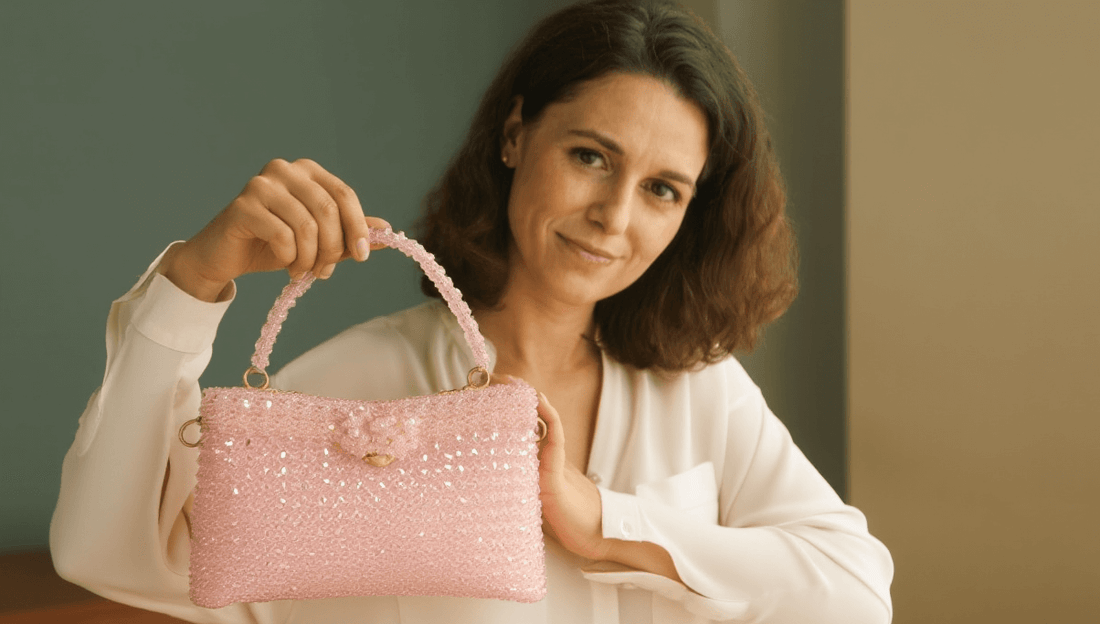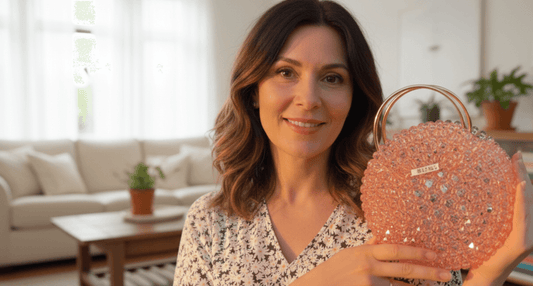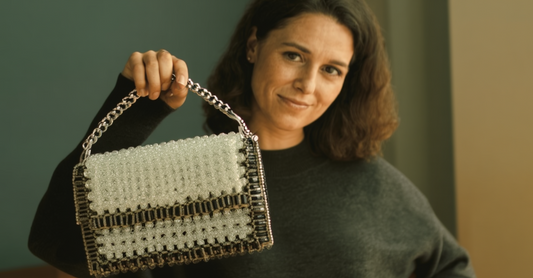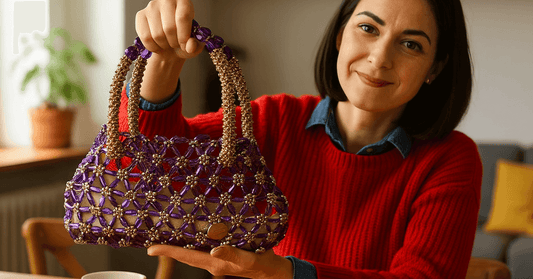How to Stiffen a Beaded Bag: Your Complete Professional Guide

How to Stiffen a Beaded Bag: Essential Methods for Structure & Durability
Learning how to stiffen a beaded bag transforms beautiful but floppy beadwork into professional-quality accessories with structure and durability that withstand regular use. Whether you've created a gorgeous beaded bag that lacks body or purchased a vintage piece needing reinforcement, stiffening your beaded bag properly ensures it maintains its shape, protects your beadwork investment, and elevates the overall appearance from homemade craft to designer-quality accessory.
Stiffening a beaded bag addresses one of the most common challenges faced by beading enthusiasts creating accessories that look as polished and structured as store-bought pieces. Without proper stiffening techniques, even the most intricate beaded bags can sag, collapse, or fail to hold their intended shape, diminishing both aesthetic appeal and functionality. Professional beaded bag makers understand that structural integrity matters as much as beautiful beadwork, with stiffening methods providing the foundation that allows your artistry to shine. https://stellar-pearl.com/collections/pearl-bag
The good news is that stiffening a beaded bag doesn't require advanced skills or expensive equipment. Using accessible materials like plastic canvas, interfacing, or fabric stiffeners, you can transform soft beaded bags into structured accessories that stand upright, maintain clean lines, and function beautifully for years. These techniques work whether you're creating new beaded bags from scratch or rehabilitating existing pieces that have lost their shape over time.
Understanding how to stiffen a beaded bag opens new possibilities for your beadwork projects. You'll be able to create structured handbags, clutches with crisp edges, and evening bags that maintain elegant silhouettes. This comprehensive guide reveals professional stiffening methods used by expert beaders, ensuring your beaded bags achieve the polished, professional appearance they deserve while expressing your unique style with confidence! 💎✨👜
Understanding Beaded Bag Structure and Stiffening Needs
Before learning specific techniques for how to stiffen a beaded bag, understanding structural requirements helps you select appropriate methods for your particular project. Different beaded bag styles, sizes, and intended uses require varying levels and types of stiffening support.
Structural Support Levels for Beaded Bags
- Light Support: Small evening clutches or decorative beaded bags used occasionally need minimal stiffening—just enough to prevent complete collapse while maintaining some flexibility
- Medium Support: Daily-use beaded bags or medium-sized purses require moderate stiffening that provides shape retention while allowing the bag to adapt slightly to contents
- Heavy Support: Structured handbags, frame-style beaded bags, or pieces intended to stand upright independently need rigid stiffening that maintains precise shape regardless of contents
- Flexible Support: Soft pouches or drawstring beaded bags benefit from strategic stiffening only in specific areas like bases or openings rather than overall rigidity
- Vintage Restoration: Antique beaded bags often need gentle stiffening that preserves original character while providing sufficient support for continued use
Materials That Provide Structure
- Plastic Canvas: The most popular stiffening material for beaded bags, offering rigid support, easy customization, and holes that facilitate bead attachment
- Buckram: Traditional millinery fabric provides moderate stiffening for beaded bags requiring structure with some flexibility
- Heavy Interfacing: Fusible or sew-in interfacing offers varying stiffness levels for beaded bags needing body without complete rigidity
- Cardboard or Mat Board: Budget-friendly stiffening options for beaded bags, though less durable than specialized materials
- Commercial Fabric Stiffeners: Liquid or spray products that add body to fabric-based beaded bags through chemical treatment
Identifying Your Beaded Bag's Stiffening Requirements
- Intended Use Assessment: Determine how your beaded bag will be used—occasional formal events versus daily carrying dramatically affects stiffening needs
- Size Considerations: Larger beaded bags generally require more substantial stiffening than small clutches to prevent sagging under their own weight
- Bead Weight Factor: Heavy glass beads or dense beadwork creates more stress on beaded bag structure than lightweight plastic beads
- Handle and Strap Impact: Beaded bags with handles or straps need reinforced stiffening at attachment points to distribute weight stress
- Aesthetic Goals: Consider whether you want your beaded bag to appear soft and draped or crisp and structured when selecting stiffening methods
Common Beaded Bag Structure Problems
- Sagging Bottom: The base of your beaded bag collapses or sinks, making it difficult to access contents
- Floppy Sides: Side panels lack structure, causing your beaded bag to fold inward or lose its intended shape
- Weak Opening: The top edge of your beaded bag doesn't maintain shape, making opening and closing awkward
- Handle Stress Points: Areas where handles attach show distortion or pulling on your beaded bag body
- Overall Collapse: Your entire beaded bag lacks sufficient structure to stand upright or maintain any defined shape
Understanding these structural challenges helps you select appropriate stiffening techniques that address your specific beaded bag needs effectively.
Essential Materials for Stiffening Beaded Bags
Successfully stiffening a beaded bag requires gathering appropriate materials before beginning your project. Having quality supplies ensures smooth construction and professional results that make your beaded bag both beautiful and functional.https://stellar-pearl.com/collections/pearl-bag
Primary Stiffening Materials
- Plastic Canvas Sheets: Available in 7-count or 10-count mesh, these rigid sheets (typically 8x10 inches) provide excellent structure for beaded bags requiring firm support
- Heavy-Weight Interfacing: Pellon Peltex or similar ultra-firm interfacing offers stiffness with some flexibility for beaded bags needing body without complete rigidity
- Buckram Fabric: Traditional stiffening fabric used in millinery provides moderate support ideal for vintage-style beaded bags
- Timtex or Fast2Fuse: Double-sided fusible stiff interfacing that bonds to fabric for beaded bags requiring integrated structure
- Cardstock or Mat Board: Budget alternative for stiffening beaded bags, though less durable than specialized materials
Adhesives and Attachment Materials
- Fabric Glue: Clear-drying fabric adhesive (like Aleene's Fabric Fusion) securely attaches stiffening materials to beaded bag interiors
- Double-Sided Fabric Tape: No-sew hemming tape facilitates clean edges when stiffening beaded bags without visible stitching
- Hot Glue: Quick-setting adhesive for temporary positioning while stiffening beaded bags, though less flexible than fabric glue
- Spray Adhesive: Provides even coverage for large areas when attaching stiffening materials to beaded bag bases
- Fusible Web: Heat-activated adhesive sheets that bond stiffening materials to fabric in beaded bags
Lining and Finishing Materials
- Velvet or Satin Lining Fabric: 1/4 yard of quality lining fabric protects beaded bag interiors while concealing stiffening materials
- Cotton Batting: Thin batting layers add slight padding between stiffening and lining in beaded bags for refined finish
- Bias Tape: Pre-folded fabric tape creates clean edges around stiffening materials in beaded bags
- Grosgrain Ribbon: Reinforces edges and stress points when stiffening beaded bags requiring extra durability
- Iron-On Hem Tape: Enables no-sew lining attachment when stiffening beaded bags without machine stitching
Tools and Equipment
- Craft Knife or Rotary Cutter: Sharp cutting tools for precisely trimming stiffening materials for your beaded bag
- Cutting Mat: Self-healing mat protects work surfaces while cutting stiffening materials for beaded bags
- Ruler or Measuring Tape: Accurate measurements ensure stiffening pieces fit your beaded bag perfectly
- Scissors: Sharp fabric scissors for trimming lining materials when stiffening beaded bags
- Iron: Essential for activating fusible interfacing when stiffening beaded bags with heat-activated materials
- Clips or Clothespins: Hold materials in place while glue dries during beaded bag stiffening process
Budget Considerations
- Basic Stiffening Kit: Expect to invest $15-25 for plastic canvas, fabric glue, and basic lining materials for your first beaded bag stiffening project
- Premium Materials: High-quality interfacing, luxury lining fabrics, and specialty adhesives might cost $30-45 for stiffening beaded bags
- Multi-Project Supplies: Buying materials in bulk reduces per-project costs when stiffening multiple beaded bags
- Tool Investment: Quality cutting tools and rulers ($20-40) serve hundreds of future beaded bag projects
- Material Efficiency: Calculate precise measurements before cutting to minimize waste when stiffening beaded bags
Proper material selection forms the foundation of successful beaded bag stiffening, ensuring your finished accessory maintains its structure and beauty for years of enjoyment.
Step-by-Step Plastic Canvas Stiffening Method
The plastic canvas method represents the most popular and effective technique for stiffening beaded bags, providing rigid structure that maintains shape while offering convenient attachment points for beadwork. This comprehensive approach works beautifully for creating professional beaded bags from scratch or reinforcing existing pieces. https://stellar-pearl.com/collections/pearl-bag
Planning and Measuring Your Canvas
- Pattern Creation: Trace your desired beaded bag shape onto paper, adding 1/4-inch seam allowances on all sides for assembly flexibility
- Panel Identification: Divide your beaded bag design into separate panels—typically front, back, bottom, and two sides for structured handbag styles
- Canvas Selection: Choose 7-count plastic canvas for larger beaded bags (easier to work with) or 10-count for small clutches requiring finer detail
- Cutting Precision: Use sharp scissors or craft knife to cut canvas panels for your beaded bag, ensuring straight edges and clean corners
- Dry-Fit Testing: Arrange cut panels to verify they align properly before beginning permanent assembly of your beaded bag
Beading Directly onto Canvas
- Starting Method: Thread fluorocarbon line (0.4mm thickness) through canvas holes, leaving 6-inch tail for securing when stiffening your beaded bag
- Bead Attachment Pattern: String one crystal bead per canvas hole, pulling firmly so beads sit flush against the plastic for your beaded bag
- Row Progression: Work row by row across canvas, threading back through holes in opposite direction to create secure cross-pattern for beaded bags
- Tension Consistency: Maintain even thread tension throughout your beaded bag to prevent warping or gaps between beads
- Thread Management: When thread runs short, weave ends through nearby beads, add glue dot, trim excess before continuing your beaded bag
Assembling Canvas Panels
- Edge Alignment: Position beaded canvas panels edge-to-edge, ensuring corners meet precisely for your beaded bag structure
- Joining Technique: Thread line through adjacent holes on panel edges, adding extra beads for decorative reinforcement when assembling your beaded bag
- Corner Reinforcement: Create secure corners by passing thread through multiple times at stress points in your beaded bag
- Shape Testing: Periodically check that your beaded bag maintains intended shape as you join panels together
- Hardware Integration: Attach magnetic clasps by threading line through clasp loops and securing to top edges of your beaded bag
Adding Interior Lining
- Lining Measurement: Cut velvet or satin fabric slightly smaller than beaded bag interior dimensions to prevent visible edges
- Hem Preparation: Use double-sided fabric tape along raw edges, folding 1/4-inch for clean finish inside your beaded bag
- Adhesive Application: Apply fabric glue sparingly to wrong side of lining fabric for your beaded bag, avoiding seepage through beads
- Lining Installation: Carefully slide prepared lining into beaded bag, smoothing against canvas interior and pressing firmly
- Drying Process: Let lining adhere completely (15-20 minutes) before handling your finished beaded bag
The plastic canvas method creates supremely rigid beaded bags perfect for structured handbags, evening clutches, or any accessory requiring firm shape retention that stands upright independently.
Alternative Stiffening Techniques for Different Bag Styles
While plastic canvas provides excellent rigidity for stiffening beaded bags, alternative methods offer varying stiffness levels appropriate for different bag styles and aesthetic goals. Understanding these options ensures you can stiffen any beaded bag with techniques matching its specific requirements and intended use.https://stellar-pearl.com/collections/pearl-bag
Interfacing Methods for Moderate Structure
Heavy-Weight Fusible Interfacing Applications work beautifully for beaded bags requiring body without complete rigidity. Products like Pellon Peltex or Timtex provide substantial structure while maintaining some flexibility that allows your beaded bag to adapt slightly to contents. This approach suits medium-sized purses or bags where you want defined shape without the stark rigidity of plastic canvas.
To stiffen a beaded bag using fusible interfacing, first cut interfacing pieces matching your bag pattern dimensions. Place interfacing adhesive-side-down against the wrong side of your lining fabric, then press with a hot iron (no steam) for 10-15 seconds, allowing heat to activate the bonding. Once cooled, this fused combination provides both structure and finished interior in one step, simplifying construction of your beaded bag.
Sew-In Interfacing Techniques offer even more flexibility when stiffening beaded bags where you want to avoid heat application. Cut sew-in interfacing to pattern dimensions, then baste it to lining fabric using large running stitches around edges. This mechanical attachment creates structured beaded bags while preserving heat-sensitive beads or vintage materials that might be damaged by iron heat.
Buckram for Vintage-Style Beaded Bags
Traditional Buckram Application provides period-appropriate stiffening for vintage-inspired beaded bags or restoration projects on antique pieces. This loosely-woven fabric treated with sizing offers moderate stiffness with slight flexibility that suits the softer silhouettes common in historical beaded bags from the 1920s-1960s era.
When stiffening a beaded bag with buckram, cut pieces slightly larger than needed, then trim precisely after initial shaping. Buckram works best when sandwiched between beaded exterior and lining fabric, with fabric glue securing all layers together. The beauty of buckram for beaded bags lies in its authentic vintage character and the slight give that prevents the overly-stiff appearance of modern materials.
Steam-Shaping Buckram Techniques allow creating curved forms when stiffening beaded bags with dimensional designs. Hold buckram over steam from a kettle or garment steamer until slightly softened, then mold around forms to create desired curves for your beaded bag. Pin in position until completely dry, at which point the buckram retains the shaped form permanently within your finished beaded bag.
Liquid and Spray Stiffeners
Commercial Fabric Stiffener Products like Stiffy or Aleene's Fabric Stiffener offer adjustable rigidity when stiffening beaded bags made primarily from fabric rather than direct beadwork. These water-based products soak into fabric fibers, then dry to create varying stiffness levels depending on application thickness and product dilution ratios you choose for your beaded bag.
Application techniques for stiffening beaded bags with liquid products involve either brushing the stiffener onto fabric surfaces or completely immersing fabric pieces in diluted solution. For best results with beaded bags, apply 2-3 thin coats rather than one heavy application, allowing complete drying between coats. This builds up stiffness gradually while maintaining more natural fabric hand than single thick applications.
Spray Starch Alternatives provide budget-friendly options for stiffening beaded bags requiring only light body. Heavy-duty spray starch applied in multiple coats creates temporary stiffness suitable for beaded bags used occasionally rather than daily. While not as durable as other methods, spray starch allows refreshing stiffness periodically as needed, maintaining your beaded bag structure over time through repeated applications.
Strategic Partial Stiffening
Base-Only Stiffening Approaches work perfectly for beaded bags where you want the body to remain soft while ensuring the bottom maintains shape and prevents sagging. Cut rigid stiffening material (plastic canvas or heavy cardboard) to fit just the base of your beaded bag, then insert between exterior beadwork and lining. This targeted approach provides essential structure where most needed without over-engineering the entire beaded bag.
Frame and Edge Reinforcement offers another strategic option when stiffening beaded bags that benefit from defined openings and clean edges without full-body rigidity. Cut narrow strips of plastic canvas or heavy interfacing, then attach along top edges, side seams, and bottom edges of your beaded bag. These structural "bones" define shape while leaving central panels soft and flexible.
Accordion-Style Panel Stiffening creates interesting architectural effects in beaded bags by alternating rigid and flexible sections. Insert stiffening materials in alternating vertical or horizontal panels throughout your beaded bag, creating structured ridges separated by softer, more flexible areas. This technique suits contemporary design-forward beaded bags where unique structure becomes a featured design element.
follow this tutorials if you want to learn more about this tutorial
Professional Finishing and Maintenance
After successfully stiffening your beaded bag, proper finishing techniques and ongoing maintenance ensure your structured accessory maintains its professional appearance and functionality for years. These final steps separate amateur projects from truly polished beaded bags worthy of showcase.https://stellar-pearl.com/collections/pearl-bag
Edge Finishing and Clean Lines
Binding Structural Edges conceals raw edges of stiffening materials while adding refined detail to your beaded bag. Use grosgrain ribbon or bias tape in colors matching your beadwork, applying fabric glue along edges of plastic canvas or interfacing before wrapping with trim. Press firmly until adhesive sets, creating clean transitions between structural elements and decorative surfaces in your beaded bag.
Lining Edge Treatments deserve equal attention when finishing your stiffened beaded bag. Rather than leaving raw fabric edges visible inside your bag, fold edges under 1/4-inch and secure with double-sided fabric tape or neat hand-stitching. These invisible finishes inside your beaded bag demonstrate craftsmanship quality and prevent fraying that could compromise structural integrity over time.
Seam Concealment Techniques hide where beaded exterior meets stiffening materials. Apply narrow decorative trim along seam lines inside your beaded bag, or use strategic bead placement that visually distracts from construction details. Professional beaded bags reveal no evidence of internal engineering, appearing as seamless unified designs rather than assembled components.
Stress Point Reinforcement
Handle Attachment Reinforcement proves crucial for beaded bags where handles or straps connect to the main body. Beyond basic stiffening, add extra layers of interfacing or small pieces of plastic canvas at these precise points in your beaded bag. Distribute stress across wider areas rather than concentrating it at single attachment points, preventing tearing or distortion in your finished beaded bag.
Bottom Corner Strengthening prevents the most common structural failure point in stiffened beaded bags. Apply small triangular pieces of additional stiffening material at bottom corners where base meets sides of your beaded bag, creating extra support exactly where weight stress concentrates. Secure these reinforcements with both glue and stitching for maximum durability in your beaded bag.
Closure Hardware Stabilization ensures magnetic clasps, snap closures, or zippers remain secure in your beaded bag despite repeated opening and closing. Back hardware with small patches of ultrasuede or leather on the interior side of stiffening materials in your beaded bag, spreading stress across larger surface areas. This prevents hardware from gradually pulling through stiffening materials and damaging your beaded bag structure.
Maintenance and Long-Term Care
Cleaning Stiffened Beaded Bags requires gentle approaches that preserve both beadwork and structural materials. Use soft brushes or lint rollers to remove surface dust from your beaded bag rather than water-based cleaning that might compromise stiffening materials. If deeper cleaning becomes necessary, spot-clean only affected areas of your beaded bag with barely-damp cloths, allowing complete air drying before storage.
Storage Best Practices protect your stiffened beaded bag structure during periods of non-use. Store bags upright or lying flat rather than hanging by handles, which can distort stiffening materials over time. Stuff your beaded bag interior lightly with acid-free tissue paper to maintain shape, and keep in breathable dust bags rather than plastic storage that traps moisture potentially damaging your beaded bag materials.
Periodic Structure Checks help you identify and address minor issues before they become major problems in your beaded bag. Every few months, examine stiffening materials for signs of degradation, check that lining remains securely attached, and verify hardware stays firmly anchored. Early intervention repairs maintain your beaded bag in excellent condition indefinitely rather than allowing small problems to compound into irreparable damage.
Troubleshooting Common Issues
Warping and Distortion Correction addresses beaded bags that develop shape problems after initial stiffening. If your beaded bag warps, carefully remove lining if possible, then apply additional stiffening material to affected areas. Sometimes simply adding a bottom insert of plastic canvas corrects shape issues in beaded bags that have sagged over time under bead weight.
Delamination Repair fixes situations where stiffening materials separate from beaded exteriors or lining in your beaded bag. Work small amounts of fabric glue under lifted areas using a narrow craft stick, then press firmly with weights until adhesive cures. Address delamination immediately in your beaded bag to prevent expanding to larger areas that become increasingly difficult to repair effectively.
Reinforcing Worn Stress Points extends the life of well-loved beaded bags showing wear at handles or corners. From the interior, apply small patches of interfacing or ultrasuede using fabric glue, spreading stress across wider areas than original construction. These strategic repairs allow continued use of favorite beaded bags that might otherwise require retirement due to structural failures.
FAQ How to Stiffen a Beaded Bag
What is the best material for stiffening a beaded bag?
The best material for stiffening a beaded bag depends on your desired structure level and bag style. Plastic canvas provides the most rigid support, ideal for structured handbags or beaded bags that should stand upright independently. This material works perfectly for crystal beaded purses or formal clutches requiring firm shape retention.
For beaded bags needing moderate structure with some flexibility, heavy-weight fusible interfacing like Pellon Peltex offers excellent results. This suits medium-sized purses or bags where you want defined shape without stark rigidity. Buckram provides period-appropriate stiffening for vintage-style beaded bags, while liquid fabric stiffeners work best for fabric-based bags requiring adjustable body. Consider your beaded bag's intended use when selecting stiffening materials.
Can I stiffen a beaded bag without sewing?
Yes! You can absolutely stiffen a beaded bag without any sewing using no-sew techniques. The plastic canvas method demonstrated in modern crystal bag tutorials uses fishing line or fluorocarbon thread woven through canvas holes rather than traditional sewing. Fabric glue and double-sided fabric tape attach stiffening materials and lining without stitching.
Fusible interfacing activated with iron heat bonds to fabric without sewing when stiffening beaded bags. Liquid fabric stiffeners simply brush onto existing bags, requiring no attachment sewing. These no-sew approaches make stiffening beaded bags accessible to crafters without sewing machines or advanced stitching skills, producing professional results using only adhesives and simple weaving techniques.
How do I stiffen a beaded bag that's already finished?
Stiffening an already-finished beaded bag requires working from the interior without disturbing exterior beadwork. Carefully measure your bag's interior dimensions, then cut plastic canvas, heavy interfacing, or cardboard to fit snugly inside. If your beaded bag has existing lining, gently pull it away from exterior, insert stiffening material between beadwork and lining, then re-secure lining with fabric glue.
For beaded bags without removable lining, create a fitted interior "cage" of stiffening material that slides into the bag and remains loose rather than permanently attached. Alternatively, apply liquid fabric stiffener from the interior if your beaded bag has fabric backing, brushing it onto the fabric and allowing it to dry. This adds body without requiring disassembly of your finished beaded bag.
Will stiffening a beaded bag make it heavy?
The weight impact of stiffening a beaded bag varies by material choice. Plastic canvas adds minimal weight—typically 1-2 ounces for a small clutch—while providing maximum structure for your beaded bag. Heavy interfacing adds even less weight, usually under 1 ounce for most bag sizes, making it ideal for beaded bags where you want structure without bulk.
Liquid fabric stiffeners add virtually no weight to your beaded bag since they simply coat existing fibers rather than adding material layers. However, remember that the beads themselves create most of a beaded bag's weight—stiffening materials represent only 5-10% of total weight in most finished pieces. The structural benefits of stiffening your beaded bag far outweigh minimal weight additions in nearly all cases.
How long does it take to stiffen a beaded bag?
The time required for stiffening a beaded bag depends on your chosen method and bag complexity. Using plastic canvas integrated during construction takes the longest—approximately 4-6 hours total including beading time—but creates the most professional results for your beaded bag. This time investment pays dividends through superior structure and durability.
Adding stiffening to existing beaded bags requires much less time. Cutting and inserting interfacing or plastic canvas takes 30-45 minutes, while applying liquid fabric stiffener requires only 15-20 minutes plus drying time (2-4 hours depending on humidity). Multiple coats of liquid stiffener extend this timeline but build up body gradually for your beaded bag. Plan your beaded bag stiffening project around these realistic timeframes.
Can I remove stiffening from a beaded bag if I don't like it?
The reversibility of beaded bag stiffening depends on your attachment method. Loose-inserted plastic canvas or cardboard pieces remove easily from beaded bags, allowing you to try different stiffness levels until finding your preference. Simply slide out the stiffening material and replace with alternatives if desired for your beaded bag.
Glued or fused stiffening proves more difficult to remove from beaded bags without potential damage. Fusible interfacing bonded with heat becomes permanently attached to fabric in your beaded bag. Fabric glue can sometimes be loosened with careful application of rubbing alcohol or adhesive remover, but this risks damaging beadwork or lining. Liquid fabric stiffeners are essentially permanent in beaded bags. When trying new stiffening methods, start with removable techniques until certain of your preferences.
Conclusion
Mastering how to stiffen a beaded bag elevates your beadwork from pretty craft projects to professional-quality accessories with structure and durability that rival designer pieces. Throughout this comprehensive guide, you've discovered multiple stiffening techniques—from rigid plastic canvas methods to flexible interfacing approaches—ensuring you can provide appropriate support for any beaded bag style or intended use.
The transformation that proper stiffening brings to beaded bags cannot be overstated. Structure allows your careful beadwork to display beautifully, maintaining intended shapes that showcase your artistry rather than sagging or collapsing. Stiffened beaded bags function better too, standing upright for easy access, protecting contents more effectively, and withstanding regular use without distortion. These practical benefits combine with aesthetic improvements to create accessories you'll treasure and use for years.
Remember that stiffening a beaded bag represents an investment in your craft that pays ongoing dividends. While adding stiffening materials and lining requires additional time and modest material costs, the resulting professional quality justifies this effort. Your finished beaded bags will look polished, feel substantial, and perform reliably—qualities that separate treasured handmade accessories from disappointing projects relegated to storage.
Whether you're creating structured crystal handbags, vintage-inspired clutches, or contemporary beaded accessories, the stiffening techniques you've learned ensure your beaded bags achieve their full potential. Embrace these methods to stiffen your beaded bags with confidence, creating accessories that express your unique style through beautiful structured design that stands the test of time! ✨💎👜
No comments









0 comments